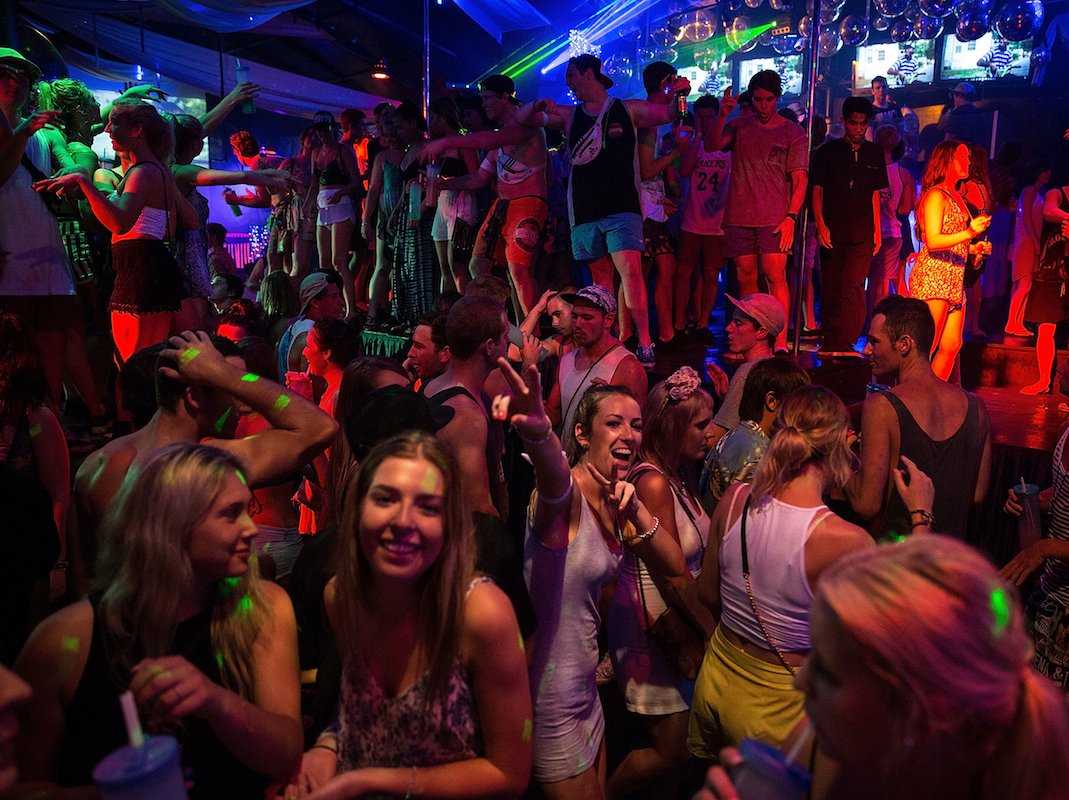These Drinking-Age Crackdowns Are Not Helping
Last weekend, police raided a bar in Norwalk, Connecticut, and found 103 underage people drinking, most of whom had no ID on them. Shocking, right? Not so much. That such people frequent bars in violation of the law is not uncommon in any college town in the US today. If they didn’t, economic conditions would be very different. What’s more, such crackdowns are not only pointless. They make the real problem much worse.
Drinking in public bars is the least of the problem. The real problem comes when the bars are threatened to enforce the law, bar the students from a safe space, and thereby push student drinkers to sketchier private spaces: dorm rooms, frat houses, and rental properties, completely outside adult supervision in lord-of-the-flies environments that peer pressure kids into abuse of themselves and others.
The whole problem could be solved with a simple change in the law that would lower the drinking age, or, at the very least, stop the enforcement of the existing restrictions. That doesn’t seem likely to happen soon. Regardless, SWAT-style raids of public bars are making the problem worse, not better.
It’s Worse than You Think
Whether parents know it (or like it) or not, kids under the age of 21 are drinking astonishing amounts of very potent liquor. Surveys of college students reveal that four in five admit to drinking in violation of the law (and I seriously doubt these surveys tell the whole truth).
One third have consumed five or more drinks in a row in the last month. These “drinks” could be beers or they could be the toxic “jungle juice” you get at a typical college party, which is basically grain alcohol with sweetened fruit juice to make it consumable. One study concluded that underage alcohol consumption constitutes 17.5% of the entire consumer market for this product. (Here is a fact sheet.)
Many of these kids are away from home for the first time, able to drink to their heart’s content, regardless of the law. A huge culture as grown up around this practice, including a full vocabulary, games, and rituals. Mostly it is just fun, but it can also lead to serious trouble for everyone involved. Let’s not be squeamish: it leads to very un-adult-like amounts of personal abuse and, often, the abuse of others.
Most of these kids have never been socialized in what it means to drink responsibly. They are living for the thrill that comes with defiance. The combination of new freedom plus liquor plus youthful derring-do leads to potentially damaged lives.
In fraternities and sororities, it all happens on private property, not public and commercial spaces, and so campus police can look the other way. Most everyone does. Indeed, being able to drink with friends, and unhampered by authority, is a major appeal of the Greek system on campus. It’s a way to get around the preposterously high drinking age. Getting around this law will consume a major part of the energy and creativity of these kids for the next three years.
As for everyone else who cannot afford to join, it’s all about a life of sneaking around, getting to know older friends, lying and hiding, pregaming before parties just in case there is no liquor there, and generally adopting a life of bingeing and purging, blackouts and hangovers, rinsing and repeating. And so on it goes for years until finally the dawn of what the state considers adulthood.
Inevitable Results
For an entire class of people, it’s the Roaring Twenties all over again. The economics of prohibition inevitably kick in. Those who are most likely to comply with the law are those who probably wouldn’t be drinking anyway. Those who do want to drink find a way, but they gravitate toward stronger drinks, a faster and more lasting buzz, and find it in sketchier ways to acquire and consume. The less available it is, the higher the profits in providing a distribution network. The more risk in the business, the less risk averse are the people employed within it.
We see this with marijuana of course, which is precisely why so many states and cities around the country are decriminalizing, with fantastically successful results. But the same is true with alcohol, and yet there is hardly a debate at all on the topic.
It’s all part of Prohibition’s legacy and a reflection of this country’s strange attitudes toward drinking in general. The drinking age in the United States of 21 was adopted in 1984 and remains one of the highest in the world. Countries that compare in severity are only a few, including Indonesia, Kazakhstan, Cameroon, Oman, Pakistan, Qatar, Sri Lanka, and Tajikistan.
Most of the rest of the world has settled on 18 for liquor and 16 for beer and wine. In practice, most European countries have very low enforcement of even that. Somehow it works just fine for them. And it’s working well in states that have liberalized a bit at a time. Wisconsin, for example, allows an 18-year old to drink in a public bar with a parent or guardian present. That’s an improvement.
Epidemic Liquor Consumption
The consequences of this draconian law have been terrible for American society. Teenage drinking is a gigantic part of American life, all done surreptitiously and mostly without responsible oversight. The market for fake IDs is ubiquitous and diffuse. Everyone in the United States has a story of kids and their abusive habits, their strategizing, their hidden flasks and risky games, their constant maneuvering to do what they know they are not supposed to do.
The drinking-age law would surely be a winner in a competition for the least obeyed law. The notion that this law is accomplishing anything to actually stop or even curb teen drinking is preposterous. Instead, we see all the unintended effects of Prohibition: over-indulgence, anti-social behavior, disrespect for the law, secrecy and sneaking, and a massive diversion of human energy.
People speak of a rape crisis on campus, and whatever the scope of the problem, the fact that women under 21 must retreat to dorm rooms and frat houses to drink puts them all in a vulnerable situation. It’s hard to imagine that consent is really there when people are falling down, passing out, and feeling mortified the next day about what happened. In fact, the law represents a true danger to women in particular because it prohibits legal access to safe public places to drink responsibly, and go home to a safe environment afterward.
Change Is Possible
There is an organization of college administrators who are fed up. It is called the Amethyst Initiative. Currently, 135 colleges have signed support for a lower drinking age. Their goal is not to encourage more drinking but to recognize the unreality of the current law, and how it has led to perverse consequences on campus.
You know the situation has to be extremely serious to get this risk-averse crowd on board. Their statement reads:
A culture of dangerous, clandestine “binge-drinking” — often conducted off-campus — has developed. Alcohol education that mandates abstinence as the only legal option has not resulted in significant constructive behavioral change among our students.
Adults under 21 are deemed capable of voting, signing contracts, serving on juries and enlisting in the military, but are told they are not mature enough to have a beer. By choosing to use fake IDs, students make ethical compromises that erode respect for the law.
Beyond the Campus
It’s not just about campus. It’s about teens and drinking in general. The law requires them to hide in private places. Such clandestine meetings can lead to compromising and dangerous situations without reliable public oversight.
It’s also about business. Convenience stores and bars, in particular, have been put in a strange position. They have been enlisted to become the enforcement arm of an unenforceable policy, which has meant haranguing customers, inventing new systems for ferreting out violators, turning the servers into cops, confiscating IDs, and creating an environment of snooping and threats in a place that should be about service and fun.
Why isn’t something done to change this? Those who are most affected have the least political power. By the time they figure out the ropes in American political life, they are turning 21 and so no longer have to deal with the problem. In practice, this means that there is no real constituency pushing for reform of these laws. That’s why they have persisted for 30 years without serious pressure to change, despite the obvious failure they have been.
There is some movement at the state level. Laws are slowly being liberalized. Even if the federal highway funding is cut, the increase in revenue from alcohol sales (and decline in enforcement costs) could make up a lot of the difference.
Regardless of the financing issues, current drinking-age law is unenforceable and destructive. The reality is that kids are going to drink. Denying that and imposing ever more draconian punishments doesn’t fix the real problems with alcohol.
What we need is a normal environment of parental and community supervision so that such drinking can occur in a responsible way. Yes, kids will probably drink more often, and yes, more kids will probably try alcohol, but they can do so in an environment of safety and responsibility. Bringing it into the light, rather than driving it underground, is the best way to solve binging and abuse. Doubling down on a bad rule, rooted in the idea that laws can change human desire, is not a workable solution.
The choice between virtue and vice is a human choice. Relying on the government to make this choice for us disables the social order’s internal mechanisms for bringing about and rewarding responsible behavior. It seems like a paradox, but it is true: The only path toward restoring sanity in teenage drinking is greater liberty. Arresting kids and bartenders on the typical Friday evening does nothing to solve the problem and even makes matters worse.













